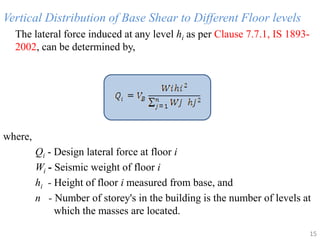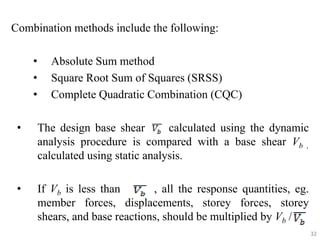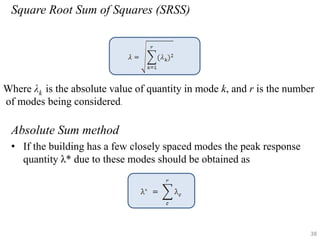This document provides an overview of different seismic analysis methods for reinforced concrete buildings according to Indian code IS 1893-2002, including linear static, nonlinear static, linear dynamic, and nonlinear dynamic analysis. It describes the basic procedures for each analysis type and provides examples of how to calculate design seismic base shear, distribute seismic forces vertically and horizontally, and determine drift and overturning effects. Case studies are presented comparing the results of static and dynamic analysis for regular and irregular multi-storey buildings modeled in SAP2000.
























































![REFERENCE
[1] Chopra AK (1995). “Dynamics of Structures Theory and Application to Earthquake Engineering”, University of California at Berkeley, USA.
[2] Duggal S K (2010). “Earthquake Resistance Design of Structure”, Fourth Edition, Oxford University Press, New Delhi.
[3] FEMA 356 (2000), “Pre-standard and Commentary for the Seismic Rehabilitation of Buildings”, American Society of Civil Engineers, USA.
[4] IS 1893 Part 1 (2002). “Indian Standard Criteria for Earthquake Resistant Design of Structures”, Bureau of Indian Standards, New Delhi.
[5] Jan. T.S, Liu. M.W. and Kao. Y.C. (2004), “An upper-bond pushover analysis procedure for estimating the seismic demands of high-rise buildings”,
Engineering structures. 117-128.
[6] Nouredine Bourahla (2013), "Equivalent Static Analysis of Structures Subjected to Seismic Actions", Encyclopedia of Earthquake Engineering, Springer-
Verlag Berlin Heidelberg.
[7] Pankaj Agarwal and Manish Shrikhande (2014)."Earthquake Resistant Design of Structures", PHI Learning Private Limited, Delhi.
[8] Prof. Sakshi Manchalwar, Akshay Mathane, Saurabh Hete and Tushar Kharabe "Comparative Study of Seismic Analysis of 3-Storey RC Frame",
International Journal of Science, Engineering and Technology Research (IJSETR), April 2016, ISSN: 2278- 7798 .
[9] Saurabh G Lonkar and Riyaz Sameer Shah, ''Comparative Study of Static and Dynamic Analysis of Multi-Storey Regular & Irregular Building-A Review",
International Journal of Research in Engineering, Science and Technologies (IJRESTs), ISSN 2395-6453.
57](https://image.slidesharecdn.com/ppt-161112044856/85/Seismic-Analysis-57-320.jpg)
